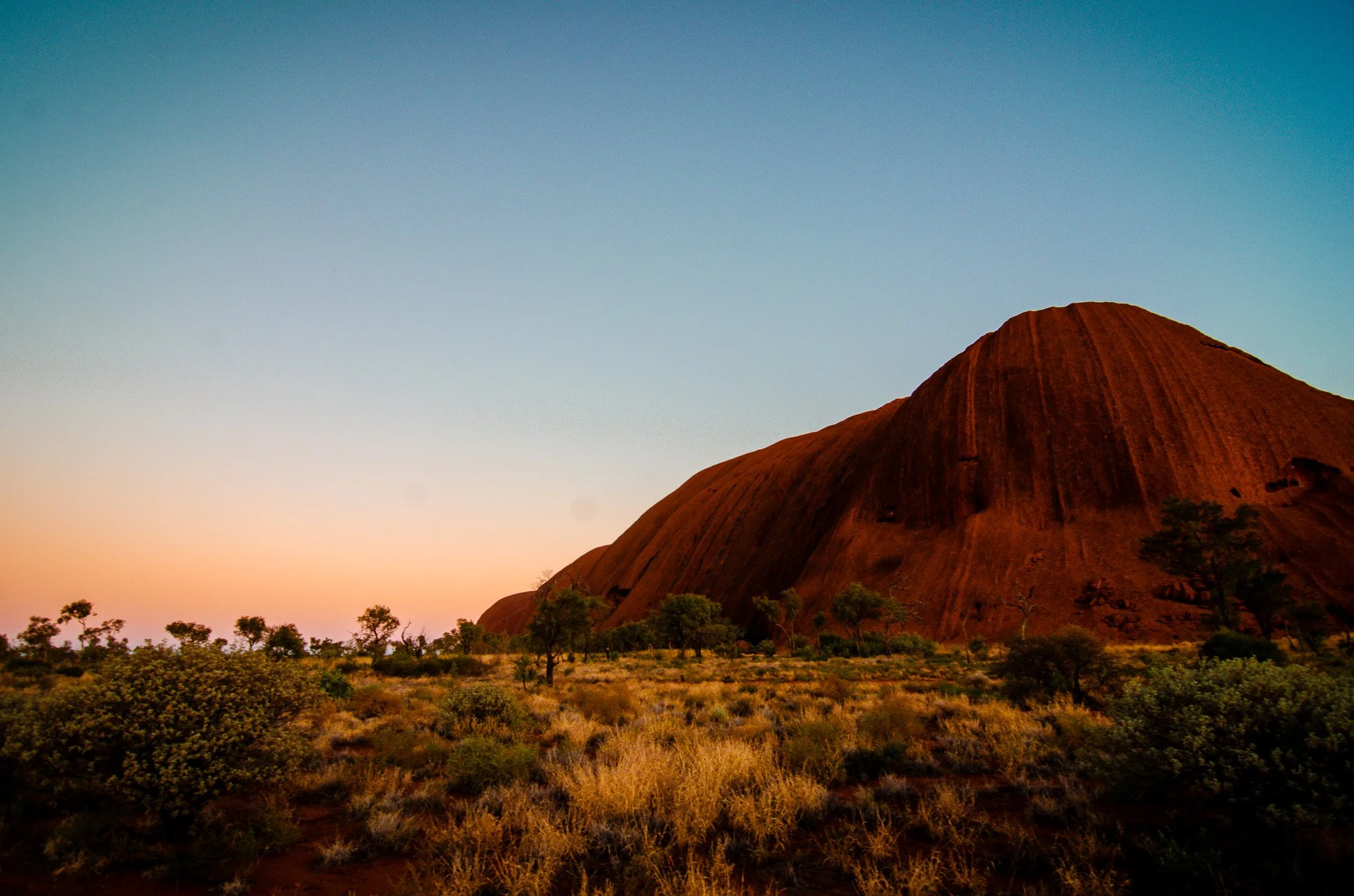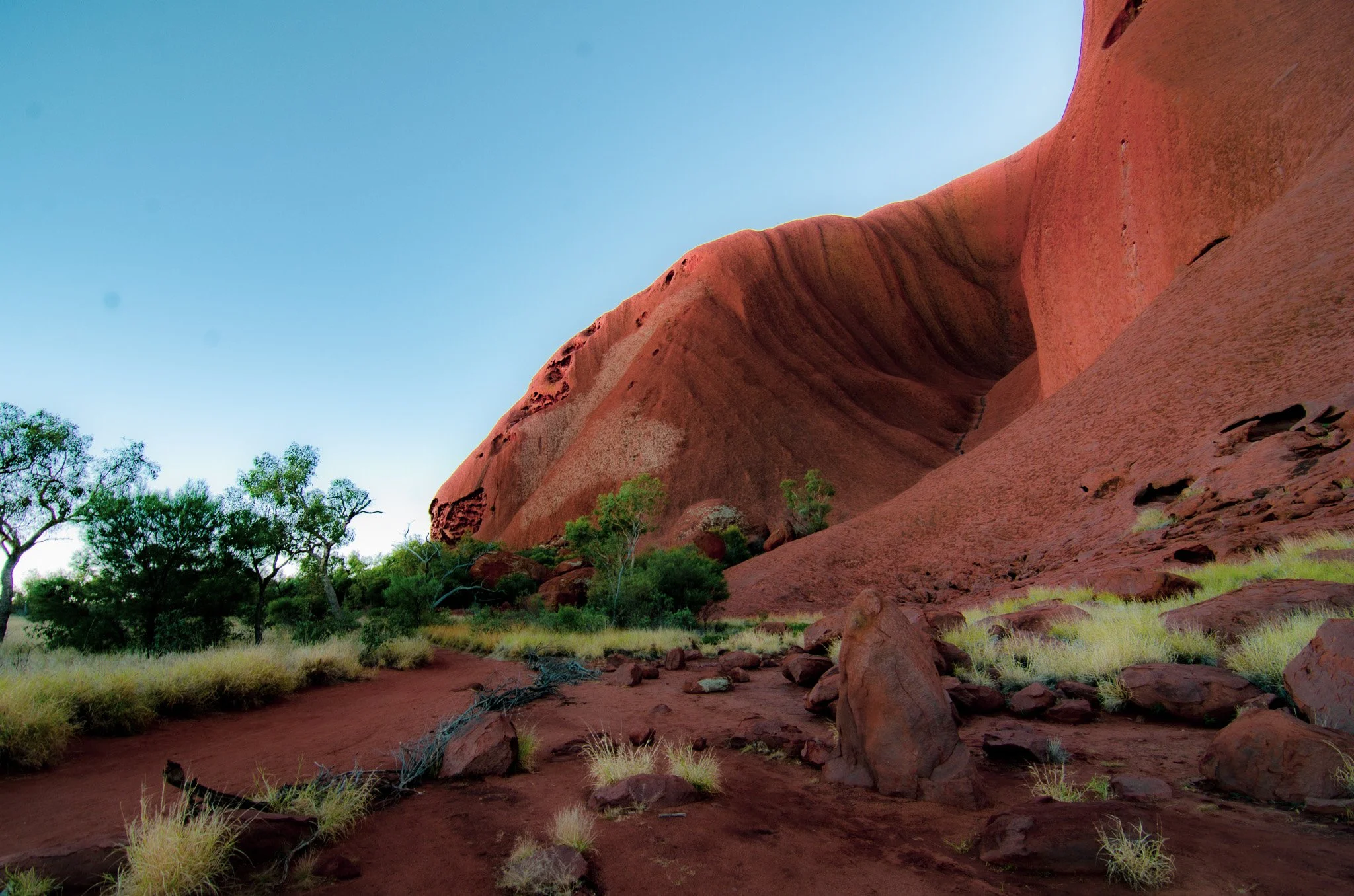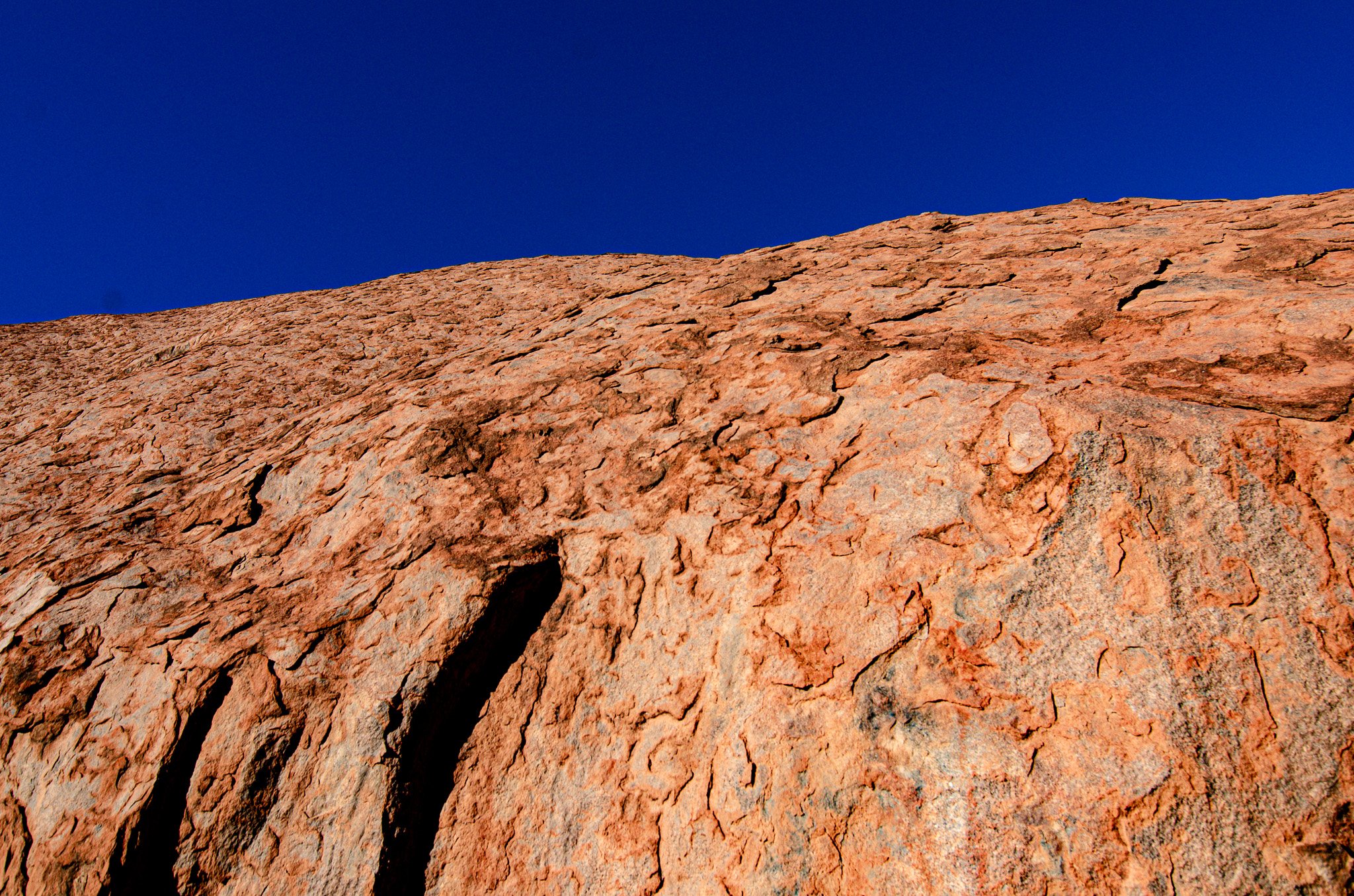Uluru - Part 2
The sky was still cloaked in darkness when we arrived at the pickup point for our Sunrise Walk tour. It was conveniently located just outside the resort. As we approached, we saw several buses already idling, headlights cutting through the early morning gloom, doors opening to collect their sleepy passengers. We hadn't expected this many people — buses coming and going in quick succession, guides calling out tour names, and groups shuffling toward whichever vehicle they hoped was theirs. It didn’t take long for confusion to set in.
The chaos was subtle but palpable — a low-level panic shared by everyone waiting, glancing at phones, comparing tour names, eyeing each bus anxiously. Nobody wanted to miss their ride, their walk, their chance to see Uluru in that first magical light of day. Tension rose every time a bus pulled up and the tour name was shouted out. Sometimes the buses didn’t stop directly in front of the pickup point but instead parked a little ways off, making the scramble even more urgent.
We quickly learned to scan for fellow walkers who had booked the same tour. Strength in numbers, we thought — at least this way, we knew we hadn’t been left behind. Eventually, our bus arrived. The staff checked off our names and asked to see our National Park passes — a crucial detail, as the park entry wasn’t included in the tour ticket. Without it, no access. Once everyone was accounted for, we were on the move, picking up a few more guests from scattered lodgings around the small town before heading toward the park gates.
Just before sunrise, we arrived at the drop-off point. As we stepped off the bus, there it was — Uluru, quietly dominating the horizon, its massive form silhouetted against the softening sky. The colours hadn’t yet reached their peak, but the first hints of lavender and rose had begun to creep across the landscape. The air was crisp, cool, and still. There was a reverence in the way everyone moved — hushed, respectful, drawn to the rock as if pulled by some invisible thread.
The guide gathered us for a quick briefing, then we set off on the base walk — a full 10 kilometres around the rock.
This walk along the eastern side of Uluru was one of the most immersive and meaningful experiences of our journey. We started at the side of the rock that’s rarely seen in the iconic postcards — the eastern face, where the Anangu people hold sacred stories passed down through countless generations. The air was still cool, and the weight of history was palpable. The early morning light bathed the rock in soft hues, its towering walls seeming to curve protectively around us, as if the land itself was alive, listening.
We passed through areas where no photographs were allowed — spaces marked with deep grooves, carved not just by wind and time, but by ancestral stories. Some of these formations are connected to Kuniya, the python woman, whose presence resonates in the shadows of this place. The grooves, some thought to be from her battle to protect her family, carry an ancient energy. We were reminded gently by the guide that we were stepping onto sacred ground, and here, eyes should be open and hearts attentive, but cameras were to remain tucked away.
The walk continued, and as the sun began to warm the cool morning air, we were led along a ridge that stretched out like a kangaroo's tail. This is a significant site for the Anangu — a place used for initiation ceremonies, where young men would transition into adulthood through rites of passage passed down from their ancestors. The guide spoke with reverence, explaining that these ceremonies were deeply spiritual, marking important life stages, and that this part of the rock held memories of those teachings. We stood at a respectful distance, feeling the strength of its significance without needing words. The rock was silent, but it spoke volumes.
As we moved forward, we reached a quieter part of the path, shaded by trees and cool in the morning light. The guide stopped and pointed to a spot near Mutitjulu Waterhole. "This," she said softly, "is a women's place." We stood in reverent silence, taking in the soft, rounded shape of the rock. Here, Anangu women came not only to give birth but to care for sick children, seeking the healing energy of this sacred space. It felt as though the air itself was holding stories of strength and nurturing. The sense of protection here was unmistakable, and as we stood still, we felt an unseen presence watching over us — a quiet but powerful reminder of life's cycles.
We walked a little further, the coolness of the morning giving way to the warmth of the rising sun, and arrived at Mutitjulu Waterhole, a hidden sanctuary nestled in the gorge. At one point along the path, the guide pointed at the natural carving high above on the rock. She said paid attention to that carving, from certain angle the carving looks like the shape of heart. This craving was popular among the overseas visitors. The still water reflected the rock's grandeur, while the surrounding trees offered a green contrast to the red and ochre hues of Uluru. This waterhole is sacred to the Anangu people — a place that has provided sustenance for generations. The air felt heavy with memory, and our guide shared the Creation story of Kuniya, the woma python woman, who fought against Liru, the venomous snake man. As we looked up at the smooth, polished walls of the gorge, we could see the marks of water’s path during heavy rains — natural graffiti, reminding us of the rhythm of the land. Here, we could take photos, but the sacred symbols etched deeper in the rock were off-limits. The images we captured were of the rock's textures, the light that danced across its surface, but not the deep, spiritual markings left by the ancestors.
From the waterhole, we followed the path to a shallow cave, marked by soot and wear — the kitchen cave. This site was where Anangu women gathered to prepare food, nurture children, and pass on knowledge. The charred ceiling told stories of fires that had burned here for generations, where meals were shared and taught, where traditions lived in the simple act of cooking. The scent of the earth, the cool shade of the cave, and the echoes of countless voices lingered in the air.
I imagined the scene — women grinding seeds, cooking roots, laughing together as they worked. Children watched and learned, not just about food, but about the land and its deeper meaning. This was a place of teaching, of learning the rhythm of life on the land, and understanding the connection between food, family, and culture. The stories of gods and serpents shape the rock, but it was the human moments here — the nurturing, the teaching, the sharing — that brought the place to life.
Each step along the eastern side of Uluru felt like a journey deeper into the heart of the land — not just a physical walk, but a walk through time, through memory, and through culture. As we finished this section of the walk, the sun was higher in the sky, and the beauty of the rock — its silent, ancient presence — was impossible to ignore. The sacredness of the place had revealed itself not in grand gestures, but in the quiet, intimate details.
Leaving the eastern side, we entered the western face of Uluru — the photographed side. This is the Uluru seen on postcards, brochures, and screensavers around the world. Everyone instinctively reached for their cameras and phones, ready to capture the famous silhouette from up close. But even though this side is well-known, it didn’t feel any less magical.
The morning sun slanted in from behind us, casting intricate shadows across the rock’s face. With each step, Uluru shifted in appearance — new creases, folds, and colours emerged. The ochre deepened into rust, the shadows softened into violet. I managed to catch the reflection of the rock in a small, unexpected pool of water that had collected in a hollow. Tufts of spinifex and desert grass clung to the stone in places, and when the light passed through them, they glowed — backlit like embers, as if the grasses themselves held fire.
The guide paused and pointed ahead to a broad curve in the rock where a large natural groove jutted out from the wall. “This one,” she said, “is a favourite for visitors.” We followed her gaze and saw it: the shape of a reclining lion, its mane etched by time, its face serene and watching. It wasn’t part of the ancient stories, but it was a reminder of how nature invites our imagination to roam.
Not far from there, the guide led us to a place of deeper meaning — the site of a cautionary tale from the Anangu people’s Tjukurpa. She told us the story of a man who took and ate a kangaroo that was not his to take. The animal had been hunted by another, but this man stole it and feasted on it, disregarding the law. This act of greed and disrespect angered the ancestors. The story is carved into the land — a reminder that the rock is not just shaped by wind and rain, but by the consequences of actions and the moral compass of a community that has lived here for tens of thousands of years.
The cave where this story is remembered lies just beyond a shaded bend. Its blackened roof, streaked with the soot of ancient fires, was a solemn reminder of the generations that gathered here — not only to cook and eat but to pass down stories that taught young minds how to live well, how to respect what was not theirs, and how to be part of the land, not master of it.
As we walked, the number of people grew — a contrast to the solitude of the eastern side. But even with more footsteps, more chatter, there was still a hush, an understanding. This wasn’t just sightseeing. This was witnessing.
Uluru wasn’t done telling its stories.
The walk took just under four hours, with a short break midway where light snacks were provided — though it hardly felt like four hours at all. Time seemed to soften as we moved, each step drawing us deeper into the stories and textures of the land. The experience was not only fascinating and full of wonder, but profoundly enriching. Choosing the guided walk had been the right decision. Our guide was thoughtful, knowing exactly when to pause — at places that held meaning or sparked curiosity — and just as importantly, when to fall silent. Those quiet moments were an invitation to simply look, breathe, and let the rock speak in its own time.
She set a pace that felt gentle and inclusive, suitable for all ages and fitness levels. The track itself was easy — mostly flat, well-maintained, winding through red earth and desert grasses — allowing us to focus fully on the landscape around us.
We ended our walk at a carpark near the base of a section once used as the climbing route. The climb was officially and permanently closed in October 2019 out of respect for Anangu wishes. Yet the path it once took is still faintly visible, worn smooth by the thousands who had climbed before. A trace of the past — a reminder of how far we've come, and how far we still have to go in learning to walk with respect.
We hit the Town Square again in search of food. With no other plans for the afternoon, we returned to the room and gave in to a long, easy rest. Tonight, we had dinner under the stars — the much-anticipated Outback dining experience.
Just like the morning, we were picked up from the resort. A small group had already gathered — strangers at first glance, all waiting for the same bus. The ride was quiet, calm. Our park passes were still valid, and soon we were back within its bounds, dropped off at a slightly elevated spot with an even closer view of Uluru than the lookout from the day before.
We were welcomed with flutes of champagne and a platter of Outback canapés. I opted for juice — the bubbles weren’t for me. The view, though, was intoxicating on its own. The rock stood majestic, aglow in the warm hues of the setting sun. From this vantage point, we could make out distinct ridges and textures that hadn’t been obvious before.
The canapés were surprisingly good — enough to take the edge off our hunger, but still leaving room for the main course. As the light faded, we were ushered to the dining area. By then, the rock had slipped into shadow, hidden from view, but its presence lingered, felt even in the dark.
We were told to sit wherever we liked, and we picked a table toward the back. Others joined us, and though we were strangers, soon a quiet camaraderie formed. First a few polite exchanges, then someone cracked a joke. A ripple of laughter. Before we knew it, the table was alive with conversation — sharing travel stories, asking questions, comparing highlights. A seasonal soup was served for starters, and for a moment, everyone went quiet again — not out of awkwardness, but simple appreciation.
Dinner followed buffet-style. The offerings were decent — not gourmet, but more than satisfying, especially considering it had all been pre-prepared. And while the food was good, it wasn’t the star of the evening. It was the atmosphere — the desert air, the open sky, the unexpected warmth of shared stories with strangers. That fleeting connection you make in travel — brief, but memorable. The kind you carry with you.
During dinner, a live didgeridoo performance filled the space with its deep, otherworldly tones. I’d heard it before, but never like this. Out here, in the open desert, under a sky heavy with stars, it sounded haunted and mysterious — like a song of the land itself. Then came a fascinating stargazing talk. The guide pointed out constellations, their stories and meaning — both Western and Indigenous. It reminded me how much the sky has always been a map, a calendar, and a storybook, depending on who’s looking.
After dessert and one last quiet moment with our dinner companions, we were gently led down a softly lit path toward the Field of Light. The night had deepened, stars scattered like diamonds overhead. And in the distance — a shimmering glow, low and steady.
We arrived.
Spread across the red earth were over 50,000 lights, like a dreamscape pulled straight from the sky. They pulsed and changed colour slowly — whites, purples, reds, blues — breathing in harmony with the land. The field stretched far into the darkness, as if it had no end.
We wandered slowly through it, the path winding gently between clusters of glowing stems. People whispered or stayed silent. It felt sacred somehow — even though it was a modern art installation, it didn’t feel out of place. It felt like it belonged. The desert held it gently, almost like a gift.
This was Bruce Munro’s Field of Light, a work inspired by a dream — and it truly felt like walking inside one. Photographs could never do it justice. It wasn’t just what you saw, it was what you felt.
By the time we returned to the bus, I was quieter than before. Not because I was tired — though I was — but because something about the whole evening had softened me. It was a night I’d remember — not for the food, not even for the lights — but for how it all came together. A slow unfolding of moments: connection, beauty, and stillness.















